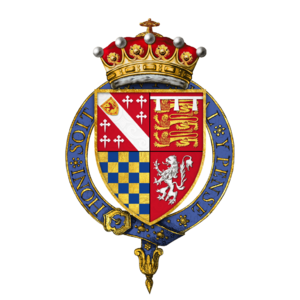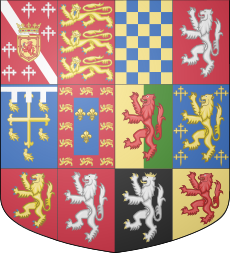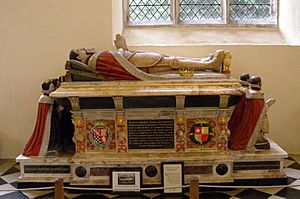Henry Howard, Earl of Surrey facts for kids
Quick facts for kids
Henry Howard
|
|
|---|---|
| Earl of Surrey | |
| Born | c. 1517 Hunsdon, Hertfordshire |
| Died | 19 January 1547 (aged 29–30) Tower Hill, Tower of London, London |
| Buried | First at the Church of All Hallows, Tower Street, London and then at Church of St Michael the Archangel, Framlingham, Suffolk |
| Noble family | Howard |
| Spouse(s) | Frances de Vere |
| Issue | Thomas Howard, 4th Duke of Norfolk Henry Howard, 1st Earl of Northampton Jane Howard, Countess of Westmorland Katherine Howard, Lady Berkeley Margaret Howard, Lady Scrope |
| Parents | Thomas Howard, 3rd Duke of Norfolk Lady Elizabeth Stafford |
| Religion | Roman Catholicism |
| Writing career | |
| Language | Early Modern English |
| Period | 16th century |
| Genres |
|
| Subjects | Beautiful lady, other |
| Literary movement | English Renaissance, Petrarchism |
Henry Howard, Earl of Surrey (born around 1517, died 19 January 1547) was an important English nobleman, politician, and poet. He helped start a new style of English poetry during the Renaissance. He was also the last person King Henry VIII ordered to be executed.
Henry Howard is often mentioned with another poet, Sir Thomas Wyatt. Because his father, Thomas Howard, 3rd Duke of Norfolk, was very powerful, Henry played a big part in court life. He also served as a soldier in both France and Scotland. Henry was known for being a bit reckless, which led to many arguments. This behavior eventually angered King Henry VIII. He was arrested, found guilty of treason, and then beheaded at Tower Hill.
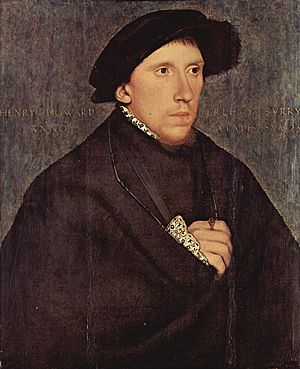
Contents
Henry Howard's Early Life
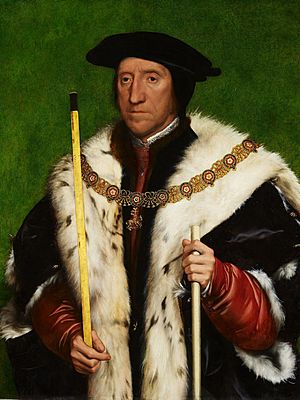
Henry was born in Hunsdon, Hertfordshire. He was the oldest son of Thomas Howard, 3rd Duke of Norfolk, and his second wife, Elizabeth Stafford. Henry was a first cousin to Anne Boleyn and Catherine Howard, who both became wives of King Henry VIII.
When Henry was born, his father's career was growing. This was largely because Henry's grandfather, Thomas Howard, 2nd Duke of Norfolk, was very powerful. His grandfathers, the Duke of Norfolk and Edward Stafford, 3rd Duke of Buckingham, were among the most powerful noblemen in England.
Henry received a good education from the best teachers of his time. Even as a young boy, he translated texts from Latin, Italian, and Spanish into English. People described Henry as intelligent and proud. He was different from many other members of his family, who were often very serious. Henry sometimes acted without thinking, which could lead to trouble.
His Career and Troubles
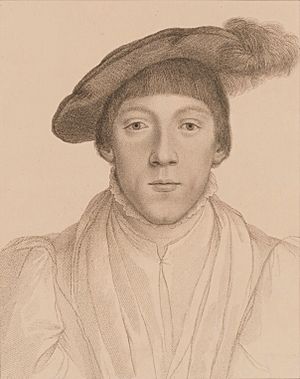
Henry grew up at Windsor Castle with Henry FitzRoy, Duke of Richmond and Somerset. FitzRoy was the illegitimate son of King Henry VIII. Henry Howard and FitzRoy became close friends. Later, Henry's sister, Mary, married FitzRoy, making them brothers-in-law.
Like his father and grandfather, Henry was a soldier. He fought in King Henry VIII's wars in France as a high-ranking officer.
Henry often got into trouble for his actions. For example, he was once jailed for hitting a courtier. Another time, he was imprisoned for walking through London streets and breaking windows. In May 1524, when his grandfather died and his father became the Duke of Norfolk, Henry received the title of Earl of Surrey. As the oldest son, he was set to become the next Duke of Norfolk.
In 1532, Henry traveled to France with his cousin Anne Boleyn, King Henry VIII, and the Duke of Richmond. He stayed there for over a year, as part of the French King Francis I of France's group. Henry returned to England in the autumn of 1533. Around this time, his sister Mary married the Duke of Richmond.
In May 1536, Henry and his father had to play a role in the trial of their relatives, Anne Boleyn and her brother. His father, the Duke of Norfolk, led the trial. Henry sat below him. In July, Henry's brother-in-law, the Duke of Richmond, died at age 17. In October, Henry helped his father put down the Pilgrimage of Grace. This was a rebellion in northern England against the King's changes to the Church.
Henry Howard was a Roman Catholic, like his father. The Howard family remained loyal to Catholicism during the Reformation. Henry was educated in the traditional Catholic faith. His Catholic beliefs were one reason for his later downfall. Years later, his oldest son, Thomas Howard, 4th Duke of Norfolk, was also executed. He was accused of planning against Queen Elizabeth I to bring Catholicism back to England.
Marriage and Children
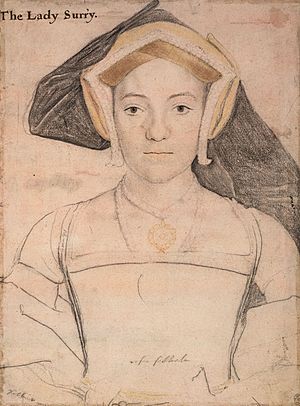
In the early 1530s, Anne Boleyn wanted her cousin Henry to marry Princess Mary. Princess Mary was King Henry VIII's only surviving child with his first wife, Catherine of Aragon. Henry's father, the Duke of Norfolk, was very excited about this idea. He thought it would give his family more power and bring them closer to the throne.
However, Anne Boleyn changed her mind. She worried that the Duke might use the marriage to support Princess Mary's claim to the throne. By October 1530, Anne convinced her uncle, the Duke of Norfolk, to arrange a different marriage for Henry. Instead, Henry married Frances de Vere. She was the daughter of John de Vere, 15th Earl of Oxford.
The marriage contract was signed on January 15, 1532. The wedding took place on April 23. Because Henry and Frances were very young, they did not start living together until 1535.
Henry and Frances had two sons and three daughters:
- Thomas Howard, 4th Duke of Norfolk: He became the Duke of Norfolk after his grandfather died in 1554.
- Henry Howard, 1st Earl of Northampton: He never married.
- Jane Howard: She married Charles Neville, 6th Earl of Westmorland.
- Katherine Howard: She married Henry Berkeley, 7th Baron Berkeley.
- Margaret Howard: She married Henry Scrope, 9th Baron Scrope of Bolton. She was born shortly after her father was executed.
His Downfall and Death
The Howard family did not like the "new men" who were gaining power at court. These included people like Thomas Cromwell and the Seymour family. Henry Howard was not careful about hiding his dislike for them.
King Henry VIII was becoming very ill. He started to believe that the Howards were planning to take the Crown from his son, Prince Edward. Henry Howard's sister, Mary, later spoke against him. This helped lead to his trial and execution for treason. Other family members, including his mother and his father's mistress, also testified against Henry and his father.
The main issue came when Henry Howard added the royal arms of Edward the Confessor to his own family's coat of arms. While his family had a right to use parts of these arms, displaying them in this way was seen as a very proud and challenging act towards the King. King Henry VIII, possibly influenced by the Seymours (who supported Protestantism), believed that Henry and his father wanted to take the throne. He thought they wanted to reverse the Reformation and bring the English Church back under the Pope's control.
Because of this, the King ordered Henry Howard and his father to be imprisoned for treason. They were sentenced to death on January 13, 1547. Henry Howard was executed on January 19, 1547. His father's execution was planned for January 28. However, King Henry VIII died that same day. The King's advisors decided not to start the new reign with more executions. So, Henry's father remained a prisoner for six years. He was released and pardoned in August 1553 when the Catholic Queen Mary I came to the throne. Henry Howard's son, Thomas, became the heir to the Dukedom of Norfolk. He inherited the title when his grandfather died in 1554.
His Burial Place
Henry Howard was first buried in the Church of All Hallows in Tower Street, London. But in 1614, his remains were moved to St Michael the Archangel's Church, Framlingham, in Suffolk. There, you can still see his amazing tomb made of painted alabaster. It is decorated with the coats of arms and animal symbols of the Howard and De Vere families. Henry's youngest son, the Earl of Northampton, had the tomb built. Henry's wife, Lady Frances, was also buried at Framlingham after she died in 1577. Her remains were placed next to her husband in the new tomb.
The tomb is not religious in its decoration. Instead, it shows the good qualities of Henry and Frances. Statues of his two sons kneel at the foot of the tomb, and his three daughters kneel at the head.
His Literary Work
Henry Howard and his friend Sir Thomas Wyatt were important figures in the Renaissance literature movement called Petrarchism. They were the first English poets to write in the sonnet form, which Shakespeare later used. Henry Howard was also the first English poet to publish blank verse. This is poetry that does not rhyme but has a regular rhythm. He used it in his translation of parts of Virgil's Aeneid.
Because of their excellent translations of Petrarch's sonnets, Wyatt and Howard are known as the "Fathers of the English Sonnet." Wyatt brought the sonnet form to English poetry. But Henry Howard gave it the rhyming pattern and structure that we see in what are now called English or Shakespearean sonnets.
A collection of poems called Tottel's Miscellany, printed in 1557, includes 40 poems by Henry Howard. One of his poems is "The Things That Cause a Quiet Life":
My friend, the things that do attain
The happy life be these, I find:
The riches left, not got with pain,
The fruitful ground; the quiet mind;
The equal friend; no grudge, no strife;
No charge of rule nor governance;
Without disease the healthy life;
The household of continuance;
The mean diet, no dainty fare;
True wisdom joined with simpleness;
The night discharged of all care,
Where wine the wit may not oppress;
The faithful wife, without debate;
Such sleeps as may beguile the night:
Content thyself with thine estate,
Neither wish death, nor fear his might.
Family Connections
|
|
|
|
|
|
|
|
|
|
|
|
|
|
|
|
|
|
|
|
16. Robert Howard of Trending Hall | |||||||||||||||
|
|
||||||||||||||||
|
|
|
|
|
|
||||||||||||
|
|
8. John Howard, 1st Duke of Norfolk |
|
||||||||||||||
|
|
||||||||||||||||
|
|
|
|
|
|
|
|
|
|||||||||
|
|
17. Margaret Mowbray | |||||||||||||||
|
|
||||||||||||||||
|
|
|
|
|
|
||||||||||||
|
|
4. Thomas Howard, 2nd Duke of Norfolk |
|
||||||||||||||
|
|
||||||||||||||||
|
|
|
|
|
|
|
|
|
|
|
|
||||||
|
|
18. William Moleyns | |||||||||||||||
|
|
||||||||||||||||
|
|
|
|
|
|
||||||||||||
|
|
9. Katherine Moleyns |
|
||||||||||||||
|
|
||||||||||||||||
|
|
|
|
|
|
|
|
|
|||||||||
|
|
19. Margery Whalesborough | |||||||||||||||
|
|
||||||||||||||||
|
|
|
|
|
|
||||||||||||
|
|
2. Thomas Howard, 3rd Duke of Norfolk |
|
||||||||||||||
|
|
||||||||||||||||
|
|
|
|
|
|
|
|
|
|
|
|
|
|
|
|||
|
|
20. Sir Philip Tilney | |||||||||||||||
|
|
||||||||||||||||
|
|
|
|
|
|
||||||||||||
|
|
10. Sir Frederick Tilney |
|
||||||||||||||
|
|
||||||||||||||||
|
|
|
|
|
|
|
|
|
|||||||||
|
|
21. Elizabeth Thorpe | |||||||||||||||
|
|
||||||||||||||||
|
|
|
|
|
|
||||||||||||
|
|
5. Elizabeth Tilney |
|
||||||||||||||
|
|
||||||||||||||||
|
|
|
|
|
|
|
|
|
|
|
|
||||||
|
|
22. Lawrence Cheney | |||||||||||||||
|
|
||||||||||||||||
|
|
|
|
|
|
||||||||||||
|
|
11. Elizabeth Cheney |
|
||||||||||||||
|
|
||||||||||||||||
|
|
|
|
|
|
|
|
|
|||||||||
|
|
23. Elizabeth Cockayne | |||||||||||||||
|
|
||||||||||||||||
|
|
|
|
|
|
||||||||||||
|
|
1. Henry Howard, Earl of Surrey |
|
||||||||||||||
|
|
||||||||||||||||
|
|
|
|
|
|
|
|
|
|
|
|
|
|
|
|
|
|
|
|
24. Humphrey Stafford, 1st Duke of Buckingham | |||||||||||||||
|
|
||||||||||||||||
|
|
|
|
|
|
||||||||||||
|
|
12. Henry Stafford, 2nd Duke of Buckingham |
|
||||||||||||||
|
|
||||||||||||||||
|
|
|
|
|
|
|
|
|
|||||||||
|
|
25. Anne Neville | |||||||||||||||
|
|
||||||||||||||||
|
|
|
|
|
|
||||||||||||
|
|
6. Edward Stafford, 3rd Duke of Buckingham |
|
||||||||||||||
|
|
||||||||||||||||
|
|
|
|
|
|
|
|
|
|
|
|
||||||
|
|
26. Richard Woodville, 1st Earl Rivers | |||||||||||||||
|
|
||||||||||||||||
|
|
|
|
|
|
||||||||||||
|
|
13. Catherine Woodville |
|
||||||||||||||
|
|
||||||||||||||||
|
|
|
|
|
|
|
|
|
|||||||||
|
|
27. Jacquetta of Luxembourg | |||||||||||||||
|
|
||||||||||||||||
|
|
|
|
|
|
||||||||||||
|
|
3. Elizabeth Stafford |
|
||||||||||||||
|
|
||||||||||||||||
|
|
|
|
|
|
|
|
|
|
|
|
|
|
|
|||
|
|
28. Henry Percy, 3rd Earl of Northumberland | |||||||||||||||
|
|
||||||||||||||||
|
|
|
|
|
|
||||||||||||
|
|
14. Henry Percy, 4th Earl of Northumberland |
|
||||||||||||||
|
|
||||||||||||||||
|
|
|
|
|
|
|
|
|
|||||||||
|
|
29. Eleanor Poynings | |||||||||||||||
|
|
||||||||||||||||
|
|
|
|
|
|
||||||||||||
|
|
7. Eleanor Percy, Duchess of Buckingham |
|
||||||||||||||
|
|
||||||||||||||||
|
|
|
|
|
|
|
|
|
|
|
|
||||||
|
|
30. William Herbert, 1st Earl of Pembroke | |||||||||||||||
|
|
||||||||||||||||
|
|
|
|
|
|
||||||||||||
|
|
15. Maud Herbert, Countess of Northumberland |
|
||||||||||||||
|
|
||||||||||||||||
|
|
|
|
|
|
|
|
|
|||||||||
|
|
31. Anne Devereux, Countess of Pembroke | |||||||||||||||
|
|
||||||||||||||||
|
|
|
|
|
|
||||||||||||
See also
 In Spanish: Henry Howard para niños
In Spanish: Henry Howard para niños


